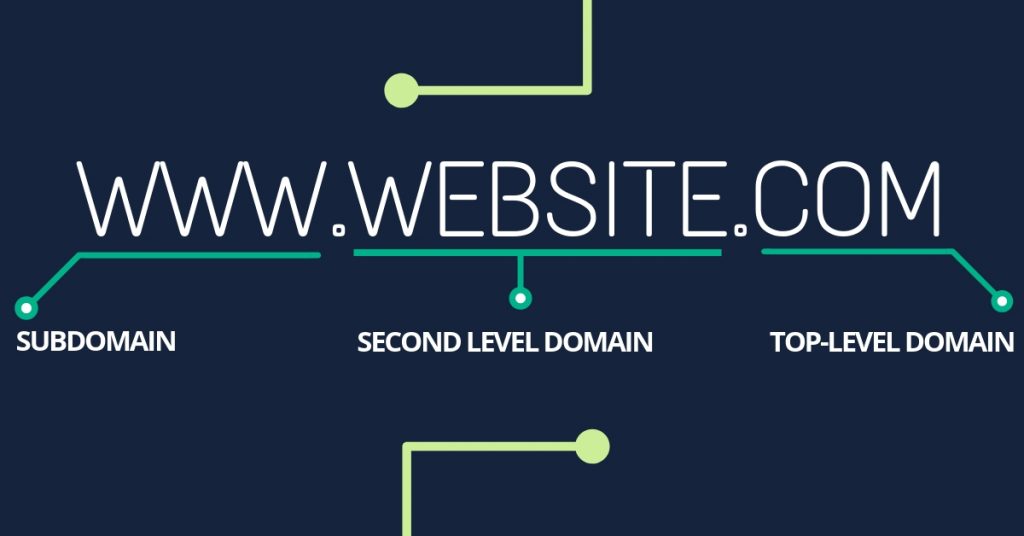Insight
What’s in a Domain Name: Sub, Second-Level, Top-Level and Country Code Domains

In the simplest terms, your domain name is your web address—the link where your website lives. Your domain name marks your place on the Internet. It’s not just your website link; it’s your online brand and unique digital footprint. If you’re interested in getting your own domain name, you may want to get familiar with URLs and how the periods in them define domain levels.
- What Are All the Parts of a Domain Name?
- What Is a Subdomain?
- What Is a Second-Level Domain (SLD)?
- What Is a Top-Level Domain (TLD)?
- What Is a Generic Top-Level Domain (gTLD)?
- What Is a Country-Code Top-Level Domain (ccTLD)?
- What Is a Sponsored Top-Level Domain (sTLD)?
Fun Fact: Oftentimes, a website link will be referred to as a URL, which is a Universal Resource Locator. This name implies that the files it’s locating (such as a website) are not on your computer, but located elsewhere. Typically, the location of your website is one of your hosting company’s servers. The URL tells the web browser how to locate the relevant information. So without a domain name, you could not have a URL, and therefore there would be nothing to navigate to!
Interestingly, you need a domain name in order to publish your website, but you do not need a website in order to have a place for your domain name to redirect or forward to. A domain name provides you with a number of options to market your business or brand to your customers as well as stay in contact with them. Here’s everything you need to know about the wonders that are domain names!
What Are All the Parts of a Domain Name?
There are three parts to a domain name: a subdomain, a second-level domain, and a top-level domain. For example, if you currently own myblog.wordpress.com, the “myblog” section would be a subdomain, the “wordpress” section would be the second-level domain (SLD) and the “.com” would be the top-level domain (TLD). Hover offers over 300 top-level domains so you have an endless selection of domain names to own.

What Is a Subdomain?
A subdomain is related to the main or root domain and is the portion to the left of your second-level domain. If you own your own domain, such as myexample.org and decide to operate a blog on a subdomain, your domain would read as blog.myexample.org. Sometimes you will see subdomains referred to as “third-level domains.”
Subdomains are often used:
- When companies pursue entirely separate mobile websites – A subdomain is often used in this instance (ever land on an m.website.com?). This happens when a company has initially designed and built a website that was not responsive or mobile-friendly. When Google’s push for mobile-first in ranking took place, many companies built out mobile websites to comply.
- When a company operates a platform that their user base builds off of – For example, WordPress users may or may not wish to buy a separate domain name for their blog and therefore, must build their creation off of WordPress’s second-level domain name, for example, theirbrand.wordpress.com.
- To allow for differentiation in design or branding – Subdomains are great for landing pages or for sections of your website that could stand on their own, such as a blog or shop. Many content creators, such as those on YouTube, have merchandise stores that are part of their brand, but not elemental to it. Having that section live on a subdomain attaches it to your brand, while allowing you the freedom to have a separate design, look, and feel from the rest of your content.
That image above isn’t a mistake; “www” is a subdomain as well. As you’ve no doubt noticed, it’s not strictly necessary to enter it before your second-level and top-level domains to get to a website. However, there are considerations you should know about with respect to “www” and your website.
What Is a Second-Level Domain or an SLD?
A second-level domain (SLD) is the domain below the top-level domain and is located to the left of the extension you use. When you’re browsing for a domain name on Hover, you’re in the process of naming the SLD to pair with one of the many TLDs that Hover offers. While top-level domains are restricted to a finite number of options, the possibilities for second-level domains are nearly endless. Your SLD is a great space for your brand name, product name, or your own name!
What Is a Top-Level Domain or a TLD?
Top-level domain (TLD) is a term you may have come across before in the midst of your search for the perfect domain name. TLD is a fancy term for your domain name’s extension, which are the letters to the right of your second-level domain. An example of a domain name extension that you will recognize (unless you’re brand new to the Internet… where have you been?!) is .COM. The .COM portion of your entire URL is your top-level domain, which is shortened to TLD for ease. When we refer to TLDs, we are talking about the extension only.
What Is a Generic Top-Level Domain or a gTLD?
A generic top-level domain (gTLD) refers to domain extensions that are generic in nature. These domain extensions are often common, recognizable, and have few restrictions on the domain name in terms of applicability. That means that you can feel free to register any and all of them for your brand. Google recognizes them as generic in search results, as well. Examples of a few gTLDs that Hover offers are, .COM, .NET, .XYZ, and.ONLINE. Hover sells many (hundreds!) more—so get searching!
The new and niche gTLDs:
There are many new and unique gTLDs available. If you’re looking for a way for your brand or company to stand out, having a TLD that highlights the market you are in is an interesting way to attract your audience. For example, if you sell art, having a .ART domain name is a great alternative to typical extensions. If your company is an iOS or Android app, why not have a .APP domain name? Hover offers over 400 domain extensions for the domain name you have in mind. Nearly any extension you’re looking for to promote your brand can be found on Hover.
What Is a Country-Code Top-Level Domain, or ccTLD?
A country code top-level domain (ccTLD) refers to domain extensions that are specifically for regions or countries. These domain extensions inform search engine results pages (SERPs) and users that your services are either based out of the region or targeting the region you have designated in your ccTLD. There are a few ccTLDs, such as .IO, .ME, and .TV, which Google treats as a gTLD in search since they have been shown to be commonly used outside of that geographic area for other purposes. More on that below.
Be aware that many ccTLDs have language requirements, require your company to be headquartered in a certain location, or you must abide by their Internet/digital laws before you can use their ccTLD. For example, the .CA domain name extension is for Canada and has some restrictions. You must be a registered Canadian business or organization, a Canadian trademark holder, a citizen of Canada, have permanent residency in Canada, or otherwise qualify under the Canadian Presence Requirements.
ccTLDs are the only top-level domains not governed by ICANN, the Internet Corporation for Assigned Names and Numbers, which governs the Internet Protocol numbers and Domain Name System. Any country can enter the market with their own TLD. A ccTLD can be easily spotted as it is always a two-letter domain extension, such as .CA, .US, or .FR.
The widespread use of ccTLDs:
Some ccTLDs have experience widespread adoptions due to meaning and translation ability across many languages. For example, .ME is a popular domain extension people use for personal branding and portfolio-style websites, but is originally Montenegro’s ccTLD. .IO, the beloved extension of tech companies and startups, is the ccTLD for the British Indian Ocean Territory. Also, .CO, used by many companies, is actually Columbia’s ccTLD. These specific ccTLDs do not have restrictions on use, hence their widespread adoption.
What Is a Sponsored Top-Level Domain, or sTLD?
A sponsored top-level domain (sTLD) is related to a very specific niche and does not allow use by general customers. There are a plethora of rules surrounding the registration and use of these types of TLDs. The sTLDs listed below are specific to the United States.
The .GOV domain can only be used by the American government. The .EDU domain is an extension that is only available to postsecondary education institutions and related organizations for registration. To be eligible to use this domain, the institution must be located in the United States, legally organized in the U.S., or recognized by a U.S. state, territorial, or federal agency.
Get Your Perfect Domain Name at Hover.com
There are a lot of things to consider when getting a domain name for your business, organization, brand, or for personal use. Ask yourself what you wish to accomplish for your brand online and consider all of the different options in regards to domain levels. The answer can help you come up with the perfect domain name.
Your next step should be to visit Hover.com. With over 400 TLDs, registering with Hover increases the chances you’ll be able to use your preferred domain name. You’ll also get free WHOIS privacy, flexible email options, and the ability to integrate your website with a number of helpful services. Don’t forget to share your awesome Hover domain with us on Hover’s social!